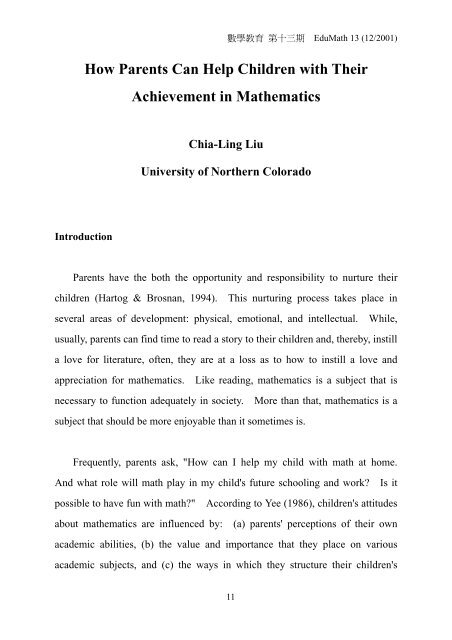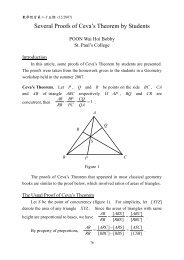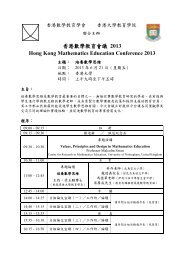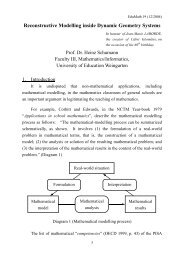how parents can help children with their achievement in mathematics
how parents can help children with their achievement in mathematics
how parents can help children with their achievement in mathematics
Create successful ePaper yourself
Turn your PDF publications into a flip-book with our unique Google optimized e-Paper software.
數 學 教 育 第 十 三 期 EduMath 13 (12/2001)How Parents Can Help Children <strong>with</strong> TheirAchievement <strong>in</strong> MathematicsChia-L<strong>in</strong>g LiuUniversity of Northern ColoradoIntroductionParents have the both the opportunity and responsibility to nurture <strong>their</strong><strong>children</strong> (Hartog & Brosnan, 1994). This nurtur<strong>in</strong>g process takes place <strong>in</strong>several areas of development: physical, emotional, and <strong>in</strong>tellectual. While,usually, <strong>parents</strong> <strong>can</strong> f<strong>in</strong>d time to read a story to <strong>their</strong> <strong>children</strong> and, thereby, <strong>in</strong>stilla love for literature, often, they are at a loss as to <strong>how</strong> to <strong>in</strong>still a love andappreciation for <strong>mathematics</strong>. Like read<strong>in</strong>g, <strong>mathematics</strong> is a subject that isnecessary to function adequately <strong>in</strong> society. More than that, <strong>mathematics</strong> is asubject that should be more enjoyable than it sometimes is.Frequently, <strong>parents</strong> ask, "How <strong>can</strong> I <strong>help</strong> my child <strong>with</strong> math at home.And what role will math play <strong>in</strong> my child's future school<strong>in</strong>g and work? Is itpossible to have fun <strong>with</strong> math?" Accord<strong>in</strong>g to Yee (1986), <strong>children</strong>'s attitudesabout <strong>mathematics</strong> are <strong>in</strong>fluenced by: (a) <strong>parents</strong>' perceptions of <strong>their</strong> ownacademic abilities, (b) the value and importance that they place on variousacademic subjects, and (c) the ways <strong>in</strong> which they structure <strong>their</strong> <strong>children</strong>'s11
數 學 教 育 第 十 三 期 EduMath 13 (12/2001)environment.However, many <strong>parents</strong> may differ <strong>in</strong> <strong>their</strong> expectations for <strong>their</strong> <strong>children</strong>,as well as <strong>their</strong> socialization practices, <strong>in</strong> terms of <strong>their</strong> attitudes and beliefsabout <strong>children</strong>'s school <strong>achievement</strong>. The relationship between <strong>parents</strong>'attitude and <strong>children</strong>'s <strong>mathematics</strong> <strong>achievement</strong> has been studied <strong>in</strong> families <strong>in</strong>the United States, <strong>in</strong> particular, Anglo Ameri<strong>can</strong> (i.e., of European descent) andCh<strong>in</strong>ese Ameri<strong>can</strong> families (Blev<strong>in</strong>s-Knabe & Musun-Miller, 1991; Hunts<strong>in</strong>ger,Hunts<strong>in</strong>ger, Ch<strong>in</strong>g, & Lee, 2000).Research <strong>in</strong> the United StatesBlev<strong>in</strong>s-Knabe and Musun-Miller (1991) suggested that parental beliefs arerelated to parental actions and, thus, these beliefs <strong>in</strong>fluence the environment that<strong>parents</strong> provide for <strong>their</strong> <strong>children</strong>. For many <strong>children</strong>, early number skills are<strong>in</strong>tuitive and develop <strong>with</strong> little direct <strong>in</strong>tervention from <strong>parents</strong>.Jayaratne (1987) found that <strong>parents</strong> exerted a strong <strong>in</strong>fluence on thedevelopment of <strong>their</strong> <strong>children</strong>'s attitudes toward <strong>achievement</strong>. Also, Jayaratnesuggested that <strong>children</strong>'s beliefs about <strong>achievement</strong> appeared to be related to<strong>their</strong> <strong>parents</strong>' expectations about <strong>their</strong> <strong>children</strong>'s <strong>achievement</strong> but not to the<strong>parents</strong>' attitudes <strong>in</strong> regard to <strong>their</strong> <strong>children</strong>'s abilities and experiences.Blev<strong>in</strong>s-Knabe and Musun-Miller (1991) reported that <strong>parents</strong> saw themselvesas hav<strong>in</strong>g more impact on the learn<strong>in</strong>g of count<strong>in</strong>g than on other types ofnumber tasks. Typically, they perceived that they had a greater effect on <strong>their</strong>child's <strong>achievement</strong> than other <strong>parents</strong> who did not work <strong>with</strong> <strong>their</strong> <strong>children</strong> toteach them to count.12
數 學 教 育 第 十 三 期 EduMath 13 (12/2001)Peress<strong>in</strong>i (1998) exam<strong>in</strong>ed <strong>parents</strong>' <strong>in</strong>volvement <strong>in</strong> <strong>mathematics</strong> educationthrough the lens of the school <strong>mathematics</strong> reform literature. Peress<strong>in</strong>ima<strong>in</strong>ta<strong>in</strong>ed that it was important to study the role of <strong>parents</strong> <strong>in</strong> school reform aswell as <strong>their</strong> role <strong>in</strong> <strong>their</strong> <strong>children</strong>'s <strong>mathematics</strong> education. Also, <strong>parents</strong>should be <strong>in</strong>volved <strong>in</strong> the <strong>mathematics</strong> reform movement. Peress<strong>in</strong>e stated that:"To effectively <strong>in</strong>volve <strong>parents</strong> <strong>in</strong> the reform of school <strong>mathematics</strong>, the<strong>mathematics</strong> education community needs both an understand<strong>in</strong>g of the researchregard<strong>in</strong>g parental <strong>in</strong>volvement and a commitment to future research on <strong>parents</strong><strong>in</strong> <strong>mathematics</strong> education" (pp. 556-557).Wigfield (1983) found that <strong>parents</strong>' beliefs about <strong>their</strong> own <strong>achievement</strong> <strong>in</strong>regard to <strong>mathematics</strong> and <strong>their</strong> background <strong>in</strong> <strong>mathematics</strong> were not related to<strong>their</strong> <strong>children</strong>'s mathematical beliefs. However, <strong>parents</strong>' beliefs about <strong>their</strong><strong>children</strong> were related to <strong>their</strong> <strong>children</strong>'s beliefs. Although some <strong>parents</strong> mayhave lower expectations for girls <strong>in</strong> <strong>mathematics</strong>, they did not appear to directly<strong>in</strong>fluence the <strong>in</strong>tentions of either girls or boys to take more <strong>mathematics</strong>. The<strong>children</strong> seemed to have less sex differentiated views <strong>in</strong> regard to <strong>mathematics</strong>than did <strong>their</strong> <strong>parents</strong>.In <strong>their</strong> study of parental beliefs about the development of preschool<strong>children</strong>'s number skills, Blev<strong>in</strong>s-Knabe and Musun-Miller (1991) found that<strong>parents</strong> predicted that <strong>their</strong> <strong>children</strong> would solve count<strong>in</strong>g tasks prior tocomputational and number concept tasks. Also, they expected that <strong>their</strong> own<strong>children</strong> would solve all types of number tasks earlier than other parent's<strong>children</strong>. In addition, <strong>parents</strong> of boys expected them to solve all types ofnumber tasks earlier than did the <strong>parents</strong> of girls. F<strong>in</strong>ally, <strong>parents</strong> believed that13
數 學 教 育 第 十 三 期 EduMath 13 (12/2001)they and the educators <strong>in</strong> schools had the most impact on <strong>their</strong> <strong>children</strong>'s earlynumber development.Anderson (1997) conducted a study which was focused on families and<strong>mathematics</strong>. In this study of parent-child <strong>in</strong>teractions, three <strong>in</strong>terrelatedtheoretical perspectives were exam<strong>in</strong>ed: (a) contextualized learn<strong>in</strong>g, (b) socialconstructivism, and (c) mediated learn<strong>in</strong>g. A number of researchers (Anderson,1997; Baroody, 1993; Irw<strong>in</strong>, 1992; Resnick, 1992; Steffe & Cobb, 1988) have<strong>in</strong>vestigated the mathematical development of young <strong>children</strong> prior toenrollment <strong>in</strong> school, <strong>in</strong> particular, <strong>children</strong>'s conceptual development as well as<strong>their</strong> early mathematical knowledge and competence. Through task based<strong>in</strong>terviews, these researchers confirmed that preschool <strong>children</strong> haveconsiderable knowledge of count<strong>in</strong>g and related number sense. In studies ofparent-child <strong>in</strong>teractions (Rogoff, Ellis, & Gardner, 1984; Saxe, Gubernab, &Gearhart, 1987), often <strong>in</strong> cl<strong>in</strong>ical sett<strong>in</strong>gs, it was found that, not only do <strong>parents</strong>support <strong>their</strong> <strong>children</strong>'s learn<strong>in</strong>g of <strong>mathematics</strong>, but that the context <strong>in</strong>fluencesthe <strong>in</strong>structional strategies they use. In case studies of preschool <strong>children</strong>,several researchers (Anderson, 1991, 1993a; Lawler, 1990; W<strong>in</strong>ter, 1987;Zeman, 1989) identified the various ways that <strong>parents</strong> and <strong>children</strong> engage <strong>in</strong>mathematical activity at home. Specifically, they noted the use of <strong>mathematics</strong><strong>in</strong> daily life especially <strong>in</strong> the use of money. It was recommended thatpreschool <strong>children</strong> should be asked questions related to <strong>mathematics</strong> <strong>in</strong>everyday life such as: Why do we use money? What time is it? What isGrandma's telephone number? How many dolls do you have? Theseresearchers confirmed that young <strong>children</strong> were capable of understand<strong>in</strong>g fairlysophisticated ideas and concepts. F<strong>in</strong>ally, <strong>with</strong> the use of surveys and14
數 學 教 育 第 十 三 期 EduMath 13 (12/2001)<strong>in</strong>terviews <strong>with</strong> <strong>parents</strong>, Leder (1992) and Young Loveridge (1989, 1991)studied the relationships between home experiences and mathematical skills.It was found that <strong>parents</strong> from a variety of backgrounds reported a number ofdifferent activities and games they provided <strong>in</strong> the home <strong>in</strong> order to support<strong>their</strong> child's mathematical development.Also, the provision of suchmathematical activity seemed to be correlated <strong>with</strong> success <strong>in</strong> school. For thereview of literature for this current article, this author did not f<strong>in</strong>d any researchabout the nature of parent-child <strong>in</strong>teractions nor the specific types ofmathematical activities <strong>in</strong> which <strong>parents</strong> and <strong>children</strong> engage.The Perspective of Ch<strong>in</strong>ese Ameri<strong>can</strong> FamiliesHunts<strong>in</strong>ger et al. (2000) studied 120 immigrant families of Ch<strong>in</strong>ese orig<strong>in</strong>;also, the recent literature on Ch<strong>in</strong>ese and Ch<strong>in</strong>ese Ameri<strong>can</strong> families was<strong>in</strong>vestigated (Hunts<strong>in</strong>ger, Jose, & Larson, 1998; as cited <strong>in</strong> Hunts<strong>in</strong>ger et al.).In regard to attitudes toward <strong>mathematics</strong>, they found that <strong>children</strong>'s<strong>achievement</strong> <strong>in</strong> <strong>mathematics</strong> was more important for the Ch<strong>in</strong>ese <strong>parents</strong> thanfor <strong>parents</strong> <strong>in</strong> the United States. They reported that many Ch<strong>in</strong>ese Ameri<strong>can</strong><strong>parents</strong> believe that teachers <strong>in</strong> the U. S. do not assign enough homework <strong>in</strong> theprimary grades. Therefore, because mathematical skills are so important for<strong>children</strong>, often, these <strong>parents</strong> gave <strong>their</strong> <strong>children</strong> additional homework as earlyas the preschool years. Before the <strong>children</strong> could watch television or playoutside, <strong>parents</strong> expected them to complete <strong>their</strong> school homework as well asextra academic lessons.Typically, the Ch<strong>in</strong>ese regard all academic subjects as important, but there15
數 學 教 育 第 十 三 期 EduMath 13 (12/2001)are two reasons why Ch<strong>in</strong>ese Ameri<strong>can</strong> <strong>parents</strong> emphasize <strong>mathematics</strong> to agreater degree than many other U.S. <strong>parents</strong> (Hunts<strong>in</strong>ger et al., 2000). First,<strong>mathematics</strong> is an <strong>in</strong>ternational language, and it is easier for immigrant <strong>parents</strong>,whose native language is not English, to teach <strong>mathematics</strong> to <strong>their</strong> <strong>children</strong>than to teach read<strong>in</strong>g or social studies, for example. Second, <strong>in</strong> Ch<strong>in</strong>a, Taiwan,and Japan, some <strong>mathematics</strong> topics are taught earlier <strong>in</strong> the primary gradesthan they do <strong>in</strong> the U. S. For example: based on the third grade <strong>mathematics</strong>text, Math Surf (1998), published by Scott Foresman, fractions are taught dur<strong>in</strong>gthe third grade <strong>in</strong> the U. S. However, <strong>in</strong> Taiwan, fractions are taught dur<strong>in</strong>g thesecond semester of second grade (M<strong>in</strong>istry of Education, 1997). Ch<strong>in</strong>eseAmeri<strong>can</strong> <strong>parents</strong> want <strong>their</strong> <strong>children</strong> to achieve as well as <strong>their</strong> counterparts <strong>in</strong>Taiwan or Ch<strong>in</strong>a especially if they should decide to return to <strong>their</strong> country oforig<strong>in</strong>. Hunts<strong>in</strong>ger et al. found that Ch<strong>in</strong>ese Ameri<strong>can</strong> <strong>children</strong> were veryadvanced <strong>in</strong> <strong>mathematics</strong> dur<strong>in</strong>g the primary school years <strong>in</strong> comparison to <strong>their</strong>Anglo Ameri<strong>can</strong> peers.Ch<strong>in</strong>ese Ameri<strong>can</strong> <strong>parents</strong> tended to use several different methods to teach<strong>their</strong> <strong>children</strong> (Hunts<strong>in</strong>ger et al., 2000). Because cultural values play animportant role <strong>in</strong> the educational <strong>achievement</strong> of Ch<strong>in</strong>ese students, Ch<strong>in</strong>ese<strong>parents</strong> are known for <strong>their</strong> will<strong>in</strong>gness to sacrifice for the sake of <strong>their</strong><strong>children</strong>'s education. In Zang and Carrasquillo's (1998) review of the literature,it was found that Ch<strong>in</strong>ese <strong>parents</strong> had an important <strong>in</strong>fluence <strong>in</strong> the academicperformance of <strong>their</strong> <strong>children</strong>. Parents assigned <strong>mathematics</strong> homework to<strong>their</strong> preschoolers and k<strong>in</strong>dergartners; some bought workbooks <strong>in</strong> Taiwan orHong Kong; and many developed <strong>their</strong> own <strong>mathematics</strong> work sheets for <strong>their</strong><strong>children</strong>. This early formal teach<strong>in</strong>g of <strong>mathematics</strong> by <strong>parents</strong> was l<strong>in</strong>ked16
數 學 教 育 第 十 三 期 EduMath 13 (12/2001)closely to these <strong>children</strong>'s higher than average scores on <strong>mathematics</strong>assessments <strong>in</strong> comparison to <strong>their</strong> Anglo Ameri<strong>can</strong> peers (Hunts<strong>in</strong>ger et al.,1997; Hunts<strong>in</strong>ger, Jose, & Larson, 1998; Hunts<strong>in</strong>ger, Larson, & Bals<strong>in</strong>k Krieg,1998; all cited <strong>in</strong> Hunts<strong>in</strong>ger et al.). However, Hunts<strong>in</strong>ger et al. did not f<strong>in</strong>dsignifi<strong>can</strong>t differences for ethnicity between Ch<strong>in</strong>ese Ameri<strong>can</strong> and EuropeanAmeri<strong>can</strong> <strong>parents</strong>' rat<strong>in</strong>gs of the importance of develop<strong>in</strong>g <strong>their</strong> <strong>children</strong>'scompetence <strong>in</strong> <strong>mathematics</strong>.Both groups of <strong>parents</strong> <strong>in</strong> the study rated it highly,although it was clear that the Ch<strong>in</strong>ese Ameri<strong>can</strong> <strong>parents</strong> did much more to foster<strong>their</strong> <strong>children</strong>'s competence <strong>in</strong> <strong>mathematics</strong>.Recommendations to Improve Children's Competence<strong>in</strong> Mathematics: Activities <strong>in</strong> the HomeThere are many methods that <strong>parents</strong> <strong>can</strong> utilize to become <strong>in</strong>volved <strong>in</strong> <strong>their</strong><strong>children</strong>'s <strong>mathematics</strong> education. There are several resources, which <strong>can</strong>provide <strong>parents</strong> <strong>with</strong> games and activities <strong>in</strong> order to engage <strong>children</strong> <strong>in</strong>mathematical th<strong>in</strong>k<strong>in</strong>g and problem solv<strong>in</strong>g and to build <strong>their</strong> self-confidenceand appreciation for <strong>mathematics</strong> at the same time. Kanter's (1994) book,Help<strong>in</strong>g Your Child Learn Math, conta<strong>in</strong>s 26 activities for <strong>children</strong> ages 5-13.These activities are based on the k<strong>in</strong>ds of <strong>mathematics</strong> that <strong>children</strong> experienceat home, at the grocery store, and while travel<strong>in</strong>g.Family Math (2001), one of the EQUAL programs from the University ofCalifornia <strong>in</strong> Berkeley, is another source for <strong>parents</strong> and <strong>children</strong> who are<strong>in</strong>terested <strong>in</strong> learn<strong>in</strong>g <strong>mathematics</strong>. The purpose of this course is to teach<strong>parents</strong> <strong>how</strong> to <strong>help</strong> <strong>their</strong> <strong>children</strong> learn <strong>mathematics</strong>. The focus is on family17
數 學 教 育 第 十 三 期 EduMath 13 (12/2001)members learn<strong>in</strong>g <strong>mathematics</strong> together.Through the related school<strong>mathematics</strong> curriculum which is provided, <strong>parents</strong> <strong>can</strong> <strong>help</strong> <strong>their</strong> <strong>children</strong> tolearn <strong>mathematics</strong>. The families who participate <strong>in</strong> this program reflect adiversity of ethnicity, gender, language, and economic status. Anotherimportant focus is to <strong>help</strong> <strong>children</strong> develop problem solv<strong>in</strong>g skills and build aconceptual understand<strong>in</strong>g of <strong>mathematics</strong> <strong>with</strong> hands-on materials. Thedevelopers of Family Math believe that all <strong>children</strong> <strong>can</strong> learn <strong>mathematics</strong> andhave fun <strong>with</strong> it. For further <strong>in</strong>formation, visit the EQUALS Program web siteat: http://www.lhs.berkeley.edu/equals /FMnetwork htm. The stated goals ofFamily Math are:1. to provide <strong>parents</strong> <strong>with</strong> activities to <strong>help</strong> <strong>their</strong> <strong>children</strong> <strong>with</strong><strong>mathematics</strong> at home;2. to provide <strong>parents</strong> <strong>with</strong> <strong>in</strong>formation about the importance of<strong>mathematics</strong> <strong>in</strong> future school<strong>in</strong>g and work;3. to <strong>in</strong>form families about the equity issues around <strong>mathematics</strong>;4. to <strong>in</strong>form <strong>parents</strong> that <strong>mathematics</strong> is important for all students;5. to build awareness that <strong>mathematics</strong> consists of more than arithmeti<strong>can</strong>d rote computations;6. to develop problem-solv<strong>in</strong>g skills and the ability to talk about<strong>mathematics</strong>;7. to build positive attitudes toward <strong>mathematics</strong>;8. to <strong>help</strong> <strong>parents</strong> feel that they <strong>can</strong> and do make a differences <strong>in</strong> <strong>their</strong><strong>children</strong>'s <strong>mathematics</strong> education; and9. to provide an opportunity for all members of the family. (Thompson &Kre<strong>in</strong>berg, 1986, p. 2)18
數 學 教 育 第 十 三 期 EduMath 13 (12/2001)In the Family Math program, <strong>parents</strong> <strong>can</strong> f<strong>in</strong>d lesson plans that are suitable for<strong>their</strong> <strong>children</strong>; also, they <strong>can</strong> f<strong>in</strong>d <strong>mathematics</strong> based games which <strong>can</strong> beplayed by the whole family and provide quality time for everyone. F<strong>in</strong>ally,professionals who are associated <strong>with</strong> Family Math, are available to answerquestions and provide <strong>in</strong>formation; such <strong>in</strong>dividuals are available <strong>in</strong> many states<strong>in</strong> the U.S.In addition, <strong>parents</strong>' attitudes toward <strong>mathematics</strong> have an impact on <strong>their</strong><strong>children</strong>'s attitudes.Children whose <strong>parents</strong> s<strong>how</strong> an <strong>in</strong>terest <strong>in</strong> andenthusiasm for <strong>mathematics</strong> around the home will be more likely to develop thatenthusiasm themselves. Parent-child participation <strong>in</strong> activities, such as thoseprovided by Kanter (1994) and the EQUAL Project (2001), <strong>help</strong>s <strong>parents</strong>communicate the importance of <strong>mathematics</strong> to <strong>their</strong> <strong>children</strong> especially whenthey become more <strong>in</strong>volved <strong>in</strong> <strong>their</strong> <strong>children</strong>'s mathematical education (Hartog& Brosnan, 1994).Read<strong>in</strong>g to <strong>children</strong> is a valued activity <strong>in</strong> many homes. What better wayto <strong>in</strong>tegrate <strong>mathematics</strong> <strong>in</strong>to the lives of <strong>children</strong> than to read them stories thatbr<strong>in</strong>g mathematical ideas to life? Accord<strong>in</strong>g to Silverman, Strawser, Strohauer,and Manzano (2001), "Children's literature offers a context for teach<strong>in</strong>g andlearn<strong>in</strong>g <strong>mathematics</strong>, especially <strong>in</strong> the elementary grades" (p. 330). Theseauthors provided a number of strategies to support <strong>children</strong>'s learn<strong>in</strong>g of<strong>mathematics</strong>. Whether the purpose of such activities is to encourage academic<strong>achievement</strong> or language development, the comb<strong>in</strong>ation of literacy and<strong>mathematics</strong> is not only enjoyed by <strong>children</strong>, but it is an effective way tosupport <strong>children</strong>'s learn<strong>in</strong>g development. Children's books that are related to19
數 學 教 育 第 十 三 期 EduMath 13 (12/2001)<strong>mathematics</strong> <strong>can</strong> be separated <strong>in</strong>to four categories: (a) count<strong>in</strong>g books, (b)number books, (c) storybooks, and (d) concept books. Gailey (1993) compileda bibliography of 159 <strong>children</strong>'s books that are connected to <strong>mathematics</strong>. Inthis bibliography, there are many excellent suggestions for mathematicallybased <strong>children</strong>'s literature to be read at home.Another important way that <strong>parents</strong> <strong>can</strong> <strong>help</strong> <strong>children</strong> <strong>in</strong> <strong>mathematics</strong> is toexhibit attitudes and values that are supportive of learn<strong>in</strong>g. Ravitch (1995; asquoted <strong>in</strong> Haury & Milbourne, 1998), addressed the follow<strong>in</strong>g words to <strong>parents</strong>"All <strong>children</strong> have two wonderful resources for learn<strong>in</strong>g--imag<strong>in</strong>ation andcuriosity. As a parent, you <strong>can</strong> awaken <strong>children</strong> to the joy of learn<strong>in</strong>g byencourag<strong>in</strong>g <strong>their</strong> imag<strong>in</strong>ation and curiosity" (p. 2).Sutton (1998; as quoted <strong>in</strong> Haury & Milbourne, 1998) offered the follow<strong>in</strong>gsuggestions for <strong>parents</strong> who want to encourage <strong>mathematics</strong> <strong>achievement</strong> <strong>in</strong><strong>their</strong> <strong>children</strong>.1. Accept the struggle as a normal part of do<strong>in</strong>g math, just as you accept thestruggle to become better <strong>in</strong> sports. Help uncover difficulties, and offersuggestions for overcom<strong>in</strong>g them.2. Encourage Mastery. Just as it is important to repeat fundamentals aga<strong>in</strong> andaga<strong>in</strong> <strong>in</strong> sports until performed automatically, it is important to see practice <strong>in</strong><strong>mathematics</strong> as develop<strong>in</strong>g mastery, not a chore or form of punishment.3. Look Beyond the Grade. Math grades are often calculated on percentagesof correct answers on tests and assignments accumulated dur<strong>in</strong>g a grad<strong>in</strong>gperiod, so they may not reflect understand<strong>in</strong>g that has developed over the courseof a grad<strong>in</strong>g period. Help focus on understand<strong>in</strong>g and be<strong>in</strong>g able to identify20
數 學 教 育 第 十 三 期 EduMath 13 (12/2001)specific difficulties.4. Discover the Textbook. "Read<strong>in</strong>g" math <strong>can</strong> be difficult, and mathtextbooks are often used as collections of assignments and homework problems.Help your child learn <strong>how</strong> to "read" the math textbook, see the underly<strong>in</strong>gstructure, and learn from the examples provided. (pp. 2-3)In Preschool Education Monthly, an early childhood publication of theHs<strong>in</strong>-yi Foundation <strong>in</strong> Taiwan, Teng (1998) recounted many real life<strong>mathematics</strong> experiences provided by <strong>parents</strong> about <strong>their</strong> <strong>in</strong>teraction <strong>with</strong> <strong>their</strong><strong>children</strong>. Parents reported that they wanted <strong>their</strong> <strong>children</strong> to be curious andknowledgeable about numbers. Many believed that the earlier that <strong>their</strong><strong>children</strong> learned <strong>mathematics</strong>, the more success they would achieve. Several<strong>parents</strong> shared <strong>their</strong> experiences: (a) one mother reported that she had seenother young <strong>children</strong> be successful <strong>in</strong> learn<strong>in</strong>g <strong>mathematics</strong>, so she decided herchild should be <strong>in</strong>troduced to it as early as possible; (b) another parent wantedher son to be skilled <strong>in</strong> problem solv<strong>in</strong>g; and (c) a third parent wanted his son toacquire good study habits and understand the methods <strong>in</strong>volved to preventfrustration when the <strong>mathematics</strong> became more difficult. Accord<strong>in</strong>g to Teng's<strong>in</strong>terviews, <strong>parents</strong> <strong>in</strong> Taiwan believe that it is a necessity that <strong>their</strong> <strong>children</strong>acquire <strong>mathematics</strong> ability and learn mathematical concepts.ConclusionHaury and Milbourne (1998) quoted E<strong>in</strong>ste<strong>in</strong> (n.d.) <strong>in</strong> regard to hisrelationship <strong>with</strong> <strong>mathematics</strong>. E<strong>in</strong>ste<strong>in</strong> stated "Do not worry about yourdifficulties <strong>in</strong> <strong>mathematics</strong>. I <strong>can</strong> assure you that m<strong>in</strong>e are still greater" (p. 1).21
數 學 教 育 第 十 三 期 EduMath 13 (12/2001)Accord<strong>in</strong>g to Haury and Milbourne (1998), "Everyone struggles <strong>with</strong><strong>mathematics</strong>, whether learn<strong>in</strong>g the multiplication tables or try<strong>in</strong>g to figure out<strong>how</strong> to stretch the monthly <strong>in</strong>come to pay bills. Some f<strong>in</strong>d <strong>mathematics</strong> easierthan others do, just as some f<strong>in</strong>d spell<strong>in</strong>g easier. Some use <strong>mathematics</strong>extensively <strong>in</strong> <strong>their</strong> work, just as some make more use of hammers. However,everyone uses <strong>mathematics</strong> daily, and limited proficiency <strong>in</strong> <strong>mathematics</strong> leadsto limited success <strong>with</strong> the daily challenges of our society" (p. 1).Sutton (1998; as quoted <strong>in</strong> Haury & Milbourne, 1998) expressed a similar view,"One of the most signifi<strong>can</strong>t th<strong>in</strong>gs <strong>parents</strong> <strong>can</strong> do is to <strong>help</strong> <strong>their</strong> <strong>children</strong>understand the normalcy and the value of struggle <strong>in</strong> <strong>mathematics</strong>" (p. 1). Toencourage <strong>children</strong>'s success <strong>in</strong> <strong>mathematics</strong>, one must <strong>help</strong> <strong>children</strong> recognizethe use of <strong>mathematics</strong> present <strong>in</strong> daily life and engage them <strong>in</strong> games andactivities that foster familiarity <strong>with</strong> numbers and mathematical th<strong>in</strong>k<strong>in</strong>g.It is the aspiration of most <strong>parents</strong> that <strong>their</strong> <strong>children</strong> learn to like and enjoy<strong>mathematics</strong>. Based on the research (Anderson, 1991, 1993b; Lawler, 1990;W<strong>in</strong>ter, 1987; Zeman, 1989), even preschool <strong>children</strong> <strong>can</strong> acquire mathematicalconcepts. In the ideas presented here, there are numerous sources that <strong>parents</strong><strong>can</strong> use to <strong>help</strong> <strong>their</strong> child become proficient, from read<strong>in</strong>g books to play<strong>in</strong>ggames. In this way, <strong>parents</strong> of primary and elementary school <strong>children</strong> <strong>can</strong>take an active role <strong>in</strong> <strong>their</strong> <strong>children</strong>’s mathematical education.22
數 學 教 育 第 十 三 期 EduMath 13 (12/2001)REFERENCESAnderson, A. (1991). Learn<strong>in</strong>g <strong>mathematics</strong> at home: A case study. Canadian Children,16(2), 47-58.Anderson, A. (1993a). Wonder<strong>in</strong>g: One child's questions and <strong>mathematics</strong> learn<strong>in</strong>g.Canadian Children, 18(2), 26-30.Anderson. A. (1993b). Learn<strong>in</strong>g <strong>mathematics</strong> <strong>in</strong> everyday context: A case study. A paperpresented at the Ameri<strong>can</strong> Educational Research Association, Atlanta, GA.Anderson, A. (1997). Family and <strong>mathematics</strong>: A study of parent-child <strong>in</strong>teractions.Journal for Research Mathematics Education, 28(4), 484-511.Baroody, A. J. (1993). The relationship between the order-irrelevance pr<strong>in</strong>ciple andcount<strong>in</strong>g skill. Journal for Research <strong>in</strong> Mathematics Education, 24, 415-427.Blev<strong>in</strong>e-Knabe, B., & Musun-Miller, L. (1991, April). Parental beliefs about thedevelopment of preschool <strong>children</strong>'s number skill. Paper presented at the biennial meet<strong>in</strong>g ofthe Society for Research <strong>in</strong> Child Development, Seattle, WA. (ERIC Document ReproductionService No. ED 338 379)EQUALS Program. (2001). Family math. University of California <strong>in</strong> Berkeley. RetrievedMarch 30, 2001 on the World Wide Web: http://www.lhs.berkeley.edu/equals/FMnetwork.htmGailey, S. K. (1993). The <strong>mathematics</strong>-<strong>children</strong>'s literature connection. Arithmetic Teacher,40(5), 258-261.Hartog, M. D., & Brosnan, P. A. (1994). Do<strong>in</strong>g <strong>mathematics</strong> <strong>with</strong> your child. RetrievedSeptember 20, 2000 on the World Wide Web: http://www.ed.gov/databases/ERIC_Digests/ed372967.htmlHaury, D. L., & Milbourne, L. A. (1998). Help<strong>in</strong>g your child learn math. RetrievedSeptember 20, 2000 on the World Wide Web: http://www.ed.gov/databases/ERIC_Digests/ed433196.htmlHunts<strong>in</strong>ger, C. S., Hunts<strong>in</strong>ger, P, R., Ch<strong>in</strong>g, W., & Lee, C. (2000). Understand<strong>in</strong>gcultural contexts fosters sensitive caregiv<strong>in</strong>g of Ch<strong>in</strong>ese Ameri<strong>can</strong> <strong>children</strong>. Young Children,55(6), 7-15.Irw<strong>in</strong>, K. (1992, August). Young <strong>children</strong>'s formation of mathematical concepts: Or 6 =7 + 5. Paper presented at the Seventh International Congress for Mathematical Education,Quebec City, Canada.Jayaratne, T. E. (1987, April). The impact of mother's math experiences on <strong>their</strong>daughters' attitude toward math. Paper presented at the biennial meet<strong>in</strong>g of the Society forResearch <strong>in</strong> Child Development, Baltimore, MD. (ERIC Document Reproduction Service No.ED 297 967)Kanter, P. F. (1999). Help<strong>in</strong>g your child learn math (2nd ed.). Wash<strong>in</strong>gton, DC: U.S.Government Pr<strong>in</strong>t<strong>in</strong>g Office. Retrieved September 30, 2000 on the World Wide Web:http://oeri4 .ed.gov/pubs '<strong>parents</strong>/Math/<strong>in</strong>dex.htmlLawler, R. W. (1990). Construct<strong>in</strong>g knowledge from <strong>in</strong>teractions. Journal ofMathematical Behavior, 9, 177-192.Leder, G. (1992). Mathematics before formal school<strong>in</strong>g. Educational Studies <strong>in</strong>Mathematics, 23, 386-396.M<strong>in</strong>istry of Education. (1997). Curriculum standards for primary schools. Taipei, Taiwan:Department of Elementary and Junior High Schools.Peress<strong>in</strong>i, D. C. (1998). The portrayal of <strong>parents</strong> <strong>in</strong> the school <strong>mathematics</strong> reformliterature: Locat<strong>in</strong>g the context for parental <strong>in</strong>volvement. Journal for Research <strong>in</strong>Mathematics Education, 29(5), 555-582.Resnick, L. B. (1992). From protoquantities to operators: Build<strong>in</strong>g mathematicalcompetence on a foundation of everyday knowledge. In G. Le<strong>in</strong>hardt, R. Putnam, & R. A.23
數 學 教 育 第 十 三 期 EduMath 13 (12/2001)Hattrup (Eds.), Analyses of arithmetic for <strong>mathematics</strong> teach<strong>in</strong>g (pp. 373-429). Hillsdale, NJ:Erlbaum.Rogoff, B., Ellis, S., & Gardner, W. (1984). Adjustment of adult-child <strong>in</strong>structionaccord<strong>in</strong>g to child's age and task. Developmental Psychology, 20, 193-199.Saxe, G., Guberman, S., & Gearhart, M. (1987). Social processes <strong>in</strong> early numberdevelopment. Monographs of the Society for Research <strong>in</strong> Child Development, 52, 2-138.Scott Foresman, Addison Wesley (1998). Math surf. Retrieved May 15, 2001 on the WorldWide Web: http://www.mathsurf.com/3/<strong>in</strong>dex.htmlSilverman, F. L., Strawser, A. B., Strohauer, D. L., & Manzano, N. N. (2001) L<strong>in</strong>ks toliterature: On the road <strong>with</strong> cholo, vato, and pano. Teach<strong>in</strong>g Children Mathematics, 7(6),330-333.Steffe, L., & Cobb, P. (1988). Construction of arithmetical mean<strong>in</strong>gs and strategies. NewYork: Spr<strong>in</strong>ger-Verlag.Teng, H. (1998, September). Does your child beg<strong>in</strong> to study <strong>mathematics</strong>? PreschoolEducation Monthly. Retrieved September 30, 1998 on the World Wide Web: http://magaz<strong>in</strong>ess<strong>in</strong>a.com/preschool/contents/199809/199809-02_1.htmlThompson, V., & Kre<strong>in</strong>berg, N. (1986). Family Math: A report of an <strong>in</strong>tervention programthat <strong>in</strong>volves <strong>parents</strong> <strong>in</strong> <strong>their</strong> <strong>children</strong>'s <strong>mathematics</strong> education. Paper presented at the annualmeet<strong>in</strong>g of the Ameri<strong>can</strong> Association for the Advancement of Science, Philadelphia. (ERICDocument Reproduction Service No. ED 295 837)Wigfield, A. (1983, April). Students' perceptions of <strong>their</strong> <strong>parents</strong>' beliefs concern<strong>in</strong>g <strong>their</strong>academic competence. Paper presented at the biennial meet<strong>in</strong>g of the Society for Research <strong>in</strong>Child Development, Detroit, MI. (ERIC Document Reproduction Service No. ED 235 926)W<strong>in</strong>ter, R. (1987). Mathophobia, Pythagoras and roller skat<strong>in</strong>g. Exeter Papers <strong>in</strong>Education, 2, 46-60.Yee, D. K. (1986). Sex equity <strong>in</strong> the home: Parents' <strong>in</strong>fluence on <strong>their</strong> <strong>children</strong>'s attitudesabout math. Paper presented at the annual meet<strong>in</strong>g of the Ameri<strong>can</strong> Education ResearchAssociation, San Francisco, CA. (ERIC Document Reproduction Service No. ED 280 717)Young Loveridge, J. (1989). The relationship between <strong>children</strong>'s home experiences and<strong>their</strong> mathematical skills on entry to school. Early Child Development and Care, 43, 43-59.Young Loveridge, J. (1991). The development of resources to improve <strong>children</strong>'snumber concepts us<strong>in</strong>g games and books. In A. Begg, B. Bell, F. Biddulph, M. Carr, M. Carr,J. McChesney, & J. Young Loveridge (Eds.), SAMEpapers (pp. 64 78). Hamilton, Australia:Longman Paul.Zang, S. Y., & Carrasquillo, A. L. (1998). Ch<strong>in</strong>ese <strong>parents</strong> <strong>in</strong>fluence on academicperformance. New York State Association for Bil<strong>in</strong>gual Education Journal 10, 46-53.Zeman, M. (1989). Introduc<strong>in</strong>g Ethan to arithmetic. Journal of Mathematical Behavior, 8,27-42.24







